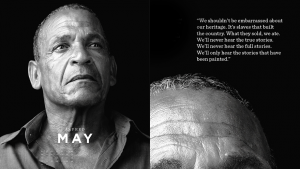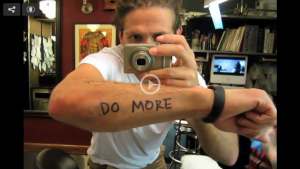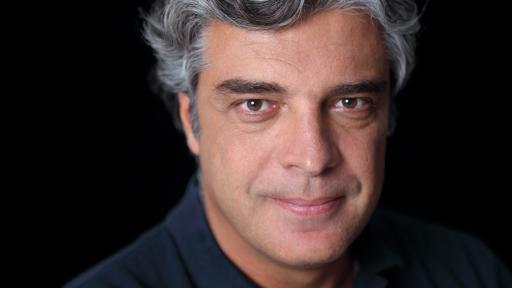Like an eagle spotting its tiny prey from high above the ground, Brazilian adman Marcello Serpa has a talent for pinpointing the standout features in a landscape of complexity. It’s a skill that has served him well in his 30 years art directing campaigns for clients such as Havaianas, Whiskas and Volkswagen.
Now a partner and creative director of AlmapBBDO in Sao Paulo, Serpa started his career studying and working in Germany where, he says, he learned the art of reduction.
“Be simple,” is the first lesson he shares with the audience at Design Indaba Conference 2014. “Try to reduce everything to a single phrase, thought, idea, visual or benefit.”
In Brazil, being simple is a necessity because of the country’s social disparities. “We have such a different scale of cultured people and illiterate people. Our social scale is so big, so you have to be simple,” he says. “You have to get the message though to everybody and it has to be immediate.”
His second lesson, following on from the first, is to be unpredictable. “If you are simple and predictable, you are dead,” cautions Serpa, a much awarded veteran of the industry at both Brazilian and international advertising festivals.
I always say I love obvious things, but the obvious thing for the first time.
His 1993 ad for Brazilian diet soft drink Guarana has no title, no headline and no copy – just an image of a woman’s lithe torso on one side and the bottle cap of the drink on the other, echoing the shape of her navel and speaking eloquently about the drink’s benefit. The ad won the Grand Prix award at Cannes for best print ad.
Similarly, a giant billboard ad for ice-cream brand Kibon uses a simple concept to associate its mango-flavoured popsicle with the freshness of the fruit itself: an image of a partially unwrapped popsicle is shown under the headline “The mango”, while the bare wooden stick after eating is “The seed”.
“Today if you go to a briefing for a mango ice-cream from any client, we are going to discuss the personality of mango, the architecture of mango, the structure of mango, what mango means to people or how mango can save your life,” Serpa says.
Simplicity is also a handy tool when budgets are strapped, says Serpa. Case in point is AlmapBBDO’s ad for Volkswagen, which stresses the manufacturer’s stringent quality control by showing a checklist of tests being ticked off and then double-ticked, with the double-tick mimicking VW’s iconic logo.
"This was cheap to produce – which is a necessity in Brazil," he notes.
We don’t have Hollywood, we don’t have George Lucas […] we were at that time in a deep crisis so we have to be very compact.
Serpa shares some valuable insights into the human and business side of advertising. Among the important things he has learned, he says, is that “great work should be rewarded by the finance department not by titles but by money. I think it’s only fair.”
Joking about the natural evolution of the typical advertising creative – from art director, creative director and global creative director/VP to sitting on awards juries and eventually writing a book, he later gets serious about the profession. He critiques agencies’ habit of making rapid promotions, which he believes are a disservice to the profession and shorten the lifespan of creatives’ careers.
On finding the right mix of talent, he has much to say.
Never work under someone who is not better than you, he proffers.
The quality of the creative work is the hero for Serpa. He contrasts working styles in Germany versus Brazil: “In Germany, the PPT [Powerpoint] presentation takes about three hours, the work is shown in 20 minutes. In Brazil, we try to make the presentation 20 minutes and the work three hours. The starting point is fundamental but if you have to explain too much, it’s not good.”
Among his other observations:
- Find a good planning partner. A good planner has a love for the outcome, the work, not just the thinking behind it.
- As a creative director building a team, set up the best one money or motivation can buy.
- When hiring people, I prefer to slow down the crazy ones than push the “nice” guys. I really like tension in a creative department.
- Put hierarchy in the bin.
- Have the most profound respect for crediting the talent responsible.
- Steak and bones for all – everyone has to have a taste of both the meaty jobs and the more mundane ones.
- There are no easy or difficult clients.
- Be hard on the work, not on people.
- Don’t ask from your team what clients ask us.
- Know what you want, even when you don’t. You have to be sure what you want, even if you’re not sure the direction you are going in is the right one.
In guiding his own creative departments, Serpa encourages them to keep in mind a series of questions: “What do we want to say? What is relevant for your product? Distill it down to a sentence. Is this relevant to the consumer? Will people embrace what you are saying? Is there something else you want to say that is more relevant?”
The product must always be the hero. “I put the product in the centre of the communication,” he notes.
The product must be the reason why you are doing this. [The product must] be in the centre, not sponsoring the laugh, the joke, the feeling.
In his own work, he tries to dissuade his clients from playing up their “do-good” credentials to win consumers’ hearts. “If everyone is doing something to save the planet, then who the fuck is destroying it?” he asks. “Do good. Don’t talk so much about it. Just do it. Beware of hypocrisy. We are in the communication business and we should not be hypocrites.”
For 17 years Serpa has been the mastermind of Havaianas’ award-winning advertising in Brazil and around the world. The flip-flop brand was AlmapBBDO’s first client. Turning a simple rubber sandal into the first truly global Brazilian brand was an organic transformation, rather than a planned one, he says. Havaianas’ advertising has stayed true to its founding formula: “Simplicity with happiness, exuberance with irreverence, design with colour… every manifestation of the brand always has the sandal in the centre.”
Within this tight framework, the brand is a riot of pattern and energy. Serpa cautions advertisers: “Never forget where you come from.”












